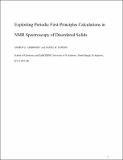Files in this item
Exploiting periodic first-principles calculations in NMR spectroscopy of disordered solids
Item metadata
| dc.contributor.author | Ashbrook, Sharon Elizabeth | |
| dc.contributor.author | Dawson, Daniel McLean | |
| dc.date.accessioned | 2014-02-28T13:01:09Z | |
| dc.date.available | 2014-02-28T13:01:09Z | |
| dc.date.issued | 2013-09-17 | |
| dc.identifier | 84712478 | |
| dc.identifier | dfacdfe0-a02c-4317-b6ac-87d919c6b29c | |
| dc.identifier | 84884224548 | |
| dc.identifier.citation | Ashbrook , S E & Dawson , D M 2013 , ' Exploiting periodic first-principles calculations in NMR spectroscopy of disordered solids ' , Accounts of Chemical Research , vol. 46 , no. 9 , pp. 1964-1974 . https://doi.org/10.1021/ar300303w | en |
| dc.identifier.issn | 0001-4842 | |
| dc.identifier.other | ORCID: /0000-0002-4538-6782/work/56638923 | |
| dc.identifier.other | ORCID: /0000-0002-8110-4535/work/34029124 | |
| dc.identifier.uri | https://hdl.handle.net/10023/4482 | |
| dc.description.abstract | Much of the information contained within solid-state nuclear magnetic resonance (NMR) spectra remains unexploited because of the challenges in obtaining high-resolution spectra and the difficulty in assigning those spectra. Recent advances that enable researchers to accurately and efficiently determine NMR parameters in periodic systems have revolutionized the application of density functional theory (DFT) calculations in solid-state NMR spectroscopy. These advances are particularly useful for experimentalists. The use of first-principles calculations aids in both the interpretation and assignment of the complex spectral line shapes observed for solids. Furthermore, calculations provide a method for evaluating potential structural models against experimental data for materials with poorly characterized structures. Determining the structure of well-ordered, periodic crystalline solids can be straightforward using methods that exploit Bragg diffraction. However, the deviations from periodicity, such as compositional, positional, or temporal disorder, often produce the physical properties (such as ferroelectricity or ionic conductivity) that may be of commercial interest. With its sensitivity to the atomic-scale environment, NMR provides a potentially useful tool for studying disordered materials, and the combination of experiment with first-principles calculations offers a particularly attractive approach. In this Account, we discuss some of the issues associated with the practical implementation of first-principles calculations of NMR parameters in solids. We then use two key examples to illustrate the structural insights that researchers can obtain when applying such calculations to disordered inorganic materials. First, we describe an investigation of cation disorder in Y2Ti(2-x)Sn(x)O7 pyrochlore ceramics using (89)Y and (119)Sn NMR. Researchers have proposed that these materials could serve as host phases for the encapsulation of lanthanide- and actinide-bearing radioactive waste. In a second example, we discuss how (17)O NMR can be used to probe the dynamic disorder of H in hydroxyl-humite minerals (nMg2SiO4·Mg(OH)2), and how (19)F NMR can be used to understand F substitution in these systems. The combination of first-principles calculations and multinuclear NMR spectroscopy facilitates the investigation of local structure, disorder, and dynamics in solids. We expect that applications will undoubtedly become more widespread with further advances in computational and experimental methods. Insight into the atomic-scale environment is a crucial first step in understanding the structure-property relationships in solids, and it enables the efficient design of future materials for a range of end uses. | |
| dc.format.extent | 11 | |
| dc.format.extent | 2755211 | |
| dc.language.iso | eng | |
| dc.relation.ispartof | Accounts of Chemical Research | en |
| dc.subject | QD Chemistry | en |
| dc.subject | SDG 3 - Good Health and Well-being | en |
| dc.subject.lcc | QD | en |
| dc.title | Exploiting periodic first-principles calculations in NMR spectroscopy of disordered solids | en |
| dc.type | Journal article | en |
| dc.contributor.sponsor | EPSRC | en |
| dc.contributor.institution | University of St Andrews. EaSTCHEM | en |
| dc.contributor.institution | University of St Andrews. School of Chemistry | en |
| dc.identifier.doi | https://doi.org/10.1021/ar300303w | |
| dc.description.status | Peer reviewed | en |
| dc.identifier.grantnumber | EP/J010510/1 | en |
This item appears in the following Collection(s)
Items in the St Andrews Research Repository are protected by copyright, with all rights reserved, unless otherwise indicated.

